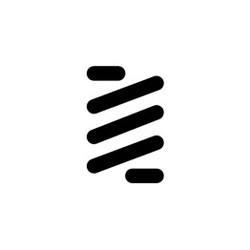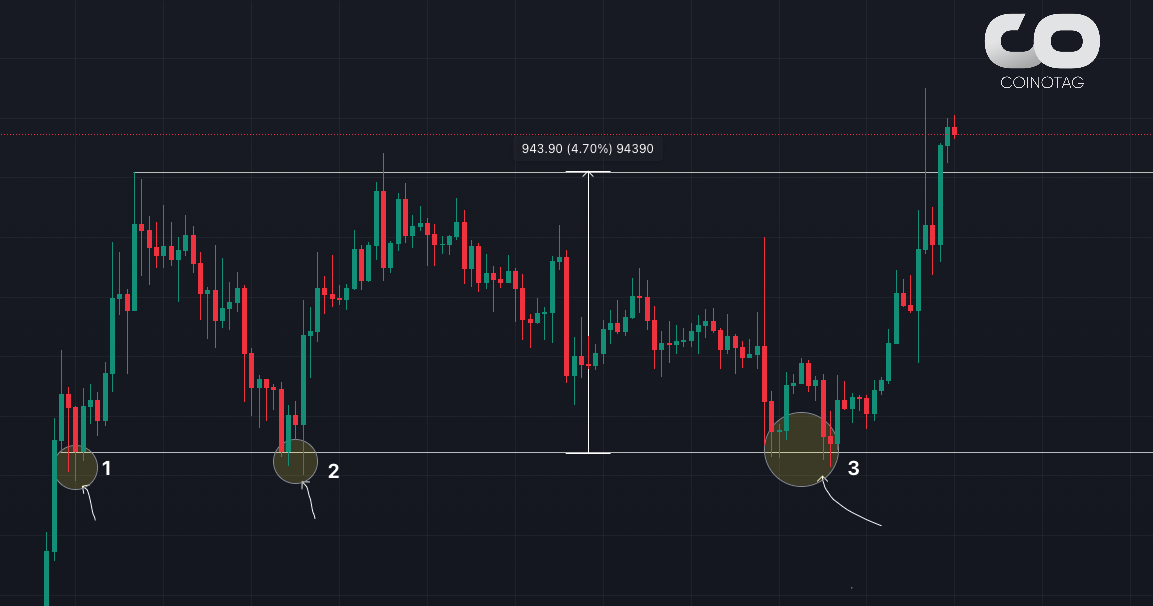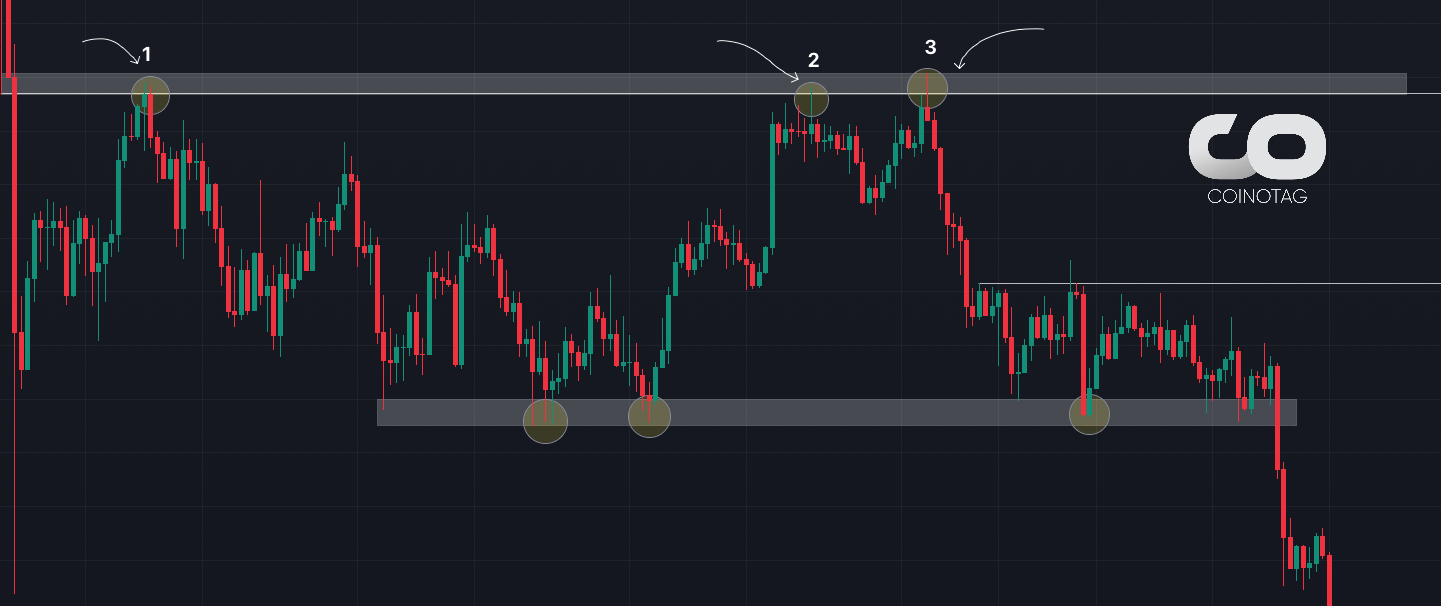Support and Resistance: Fundamental Concepts for Crypto Traders
Contents
Updated: July 2, 2023 at 05:53 AM UTC
Support and resistance are two fundamental concepts in technical analysis. Understanding what these terms mean and their practical application is important for reading price charts accurately.
Prices move based on supply and demand factors. When demand exceeds supply, prices rise, and when supply exceeds demand, prices fall. In some cases, when supply and demand are balanced, prices move sideways.
Like many concepts in technical analysis, the explanation and logic behind technical concepts are generally easy, but mastering their application may require years of practice.
KEY POINTS
- Technical analysts identify price levels on charts using support and resistance levels. These price levels indicate a higher probability of trend reversal or consolidation.
- Support is a level where a downtrend is expected to temporarily pause due to increased buying pressure.
- Resistance is a level where an uptrend is expected to temporarily pause due to increased selling pressure.
- Market psychology plays a crucial role in predicting future market movements by considering past behavior and reacting to changing conditions.
- Support and resistance areas can be identified on charts using trend lines and moving averages.
What is Support?
In a downtrend, prices fall because demand exceeds supply. The lower the prices go, the more attractive they become for investors waiting on the sidelines to buy the cryptocurrency.
There are several easy methods to determine support levels for cryptocurrencies or other commodities. For an area to be considered as support, it must be tested at least twice and show upward movement from that area.
What is Support? How to Identify It?
Let’s analyze the above image. The price initially stayed in the area marked as 1, then continued its upward movement. It later experienced a drop and encountered buyers’ purchases at that area, leading to another upward movement.
It’s important to note that support can be represented by lines or boxes. In this example, we provided the support area as a line.
Continuing with our example, when the price returned to our first marked area (1), it experienced another increase and formed our second marked area (2). By this point, we confirmed that our line indeed represents a support area.
We then expected the price to return to the support area and bounce upward. When the price reached our support area again, we made our purchases and waited for the upward movement.
As the price returned to our support area for the third time, it formed our third marked area (3). It then initiated another upward movement, breaking through the resistance line drawn above.
If the price had returned to our resistance line without initiating an upward movement, the possibility of breaking our support area would have increased. This is because the support area would have been tested for the fourth time, and the strength of buyers in that area would have weakened.
When examining support areas, it’s also important to pay attention to the volume generated when the price reaches the support area.
For example, if the price reaches our support area, but there is no immediate buying response, and the red candle has higher volume compared to previous candles, we should not rush to make purchases. Instead, we need to wait for the price to close above our support area or line.
What is Resistance?
Resistance is the opposite of support. Prices rise because demand exceeds supply. As prices increase, there will be selling pressure that exceeds the desire to buy. This can be due to various reasons, such as traders determining that prices are too high or reaching their targets.
Buyers may hesitate to open new positions at such elevated valuations. There can be various other reasons as well. However, a technical analyst will clearly see a level where supply starts to exceed demand on the price chart. This is called resistance. Similar to support, it can be a level or an area.
What is Resistance? How to Identify It?
Let’s examine the marked areas in the above image. While explaining support levels, we represented them as lines. For the identification of resistance areas, we will represent them as zones.
In the image, when the price initiated a downward movement from area 1, we considered it as our first resistance area.
Later, the price reached the upper resistance area again and encountered a drop from that area. We confirmed that it is now a resistance area.
When the price reached our marked resistance area for the third time, we can observe that it failed to close above the area due to weak volume and the overall downtrend in the market.
If the price had closed above our marked resistance area during the third touch, it would have continued the upward movement. However, as there was no candle closure above the area, the price continued its downward movement.
What to Consider When Monitoring Support:
- If a price is making horizontal movements from a support area and fails to form a new high, it indicates a continuation of the downtrend.
- When monitoring a support area, it is important to wait for candle closures above the support area before opening long positions or making spot investments.
- If the price falls below the support area, it is necessary to wait for a candle closure. The notion that “the support area is broken, but the market is in an uptrend, so this candle will turn green” is incorrect.
- The wider the time interval in chart analysis, the higher the probability of successful analysis. For example, a support area drawn on a daily chart is stronger than a support area drawn on a 15-minute chart.
What to Consider When Monitoring Resistance:
- If a price is making horizontal movements from a resistance area and fails to form a new low, it indicates a continuation of the uptrend.
- When monitoring a resistance area, it is important to wait for candle closures above the resistance area before opening long positions or makingspot investments.
- If the price is above the resistance area, it is necessary to wait for a candle closure. The notion that “the resistance area is broken, but the market is in a downtrend, so this candle will turn red” is incorrect.
- The wider the time interval in chart analysis, the higher the probability of successful analysis. For example, a resistance area drawn on a daily chart is stronger than a resistance area drawn on a 15-minute chart.
What Are Trend Lines? Do They Work as Support or Resistance?
The examples above demonstrate scenarios where a fixed area acts as an obstacle to price increase or decrease. This static barrier is one of the most popular forms of support/resistance, but the price of financial assets generally exhibits an upward or downward trend over time, which means these price barriers can change. Therefore, while learning about support and resistance, understanding the concepts of trends and trend lines is crucial.
How to Draw an Upward Trend Line?
When a cryptocurrency, despite periodic ups and downs, does not fall below the area where the initial upward movement began, it is considered to be in an upward trend.
For example, as seen in the image, since there was no candle below the starting point of the first marked trend movement (1), an upward movement occurred. Subsequently, the second marked area (2) was formed, and traders and investors track the process using the upward trend line.
When traders and investors draw the upward trend line, they connect it to the tip areas of candles 1 and 2, ensuring a precise touch. In this case, the drawn line represents the support line.
If candle closures occur below the drawn line, it indicates a trend reversal and the beginning of a downtrend in the market. This is exemplified as the fourth marked area in the image.
Jocelyn Blake
Comments
Yorumlar
Other Articles
Shenzhen’s Five-Year AI Plan Could Position City as Key Player in China-US Tech Race
December 30, 2025 at 03:43 PM UTC
SEI Consolidates Near $0.10 Support as TVL Recovers, Downside Risk Looms
December 30, 2025 at 04:16 AM UTC
Bitcoin Price Holds Near $87,500 Amid Fed’s $2.5B Liquidity, Breakout Possible
December 30, 2025 at 02:16 AM UTC



